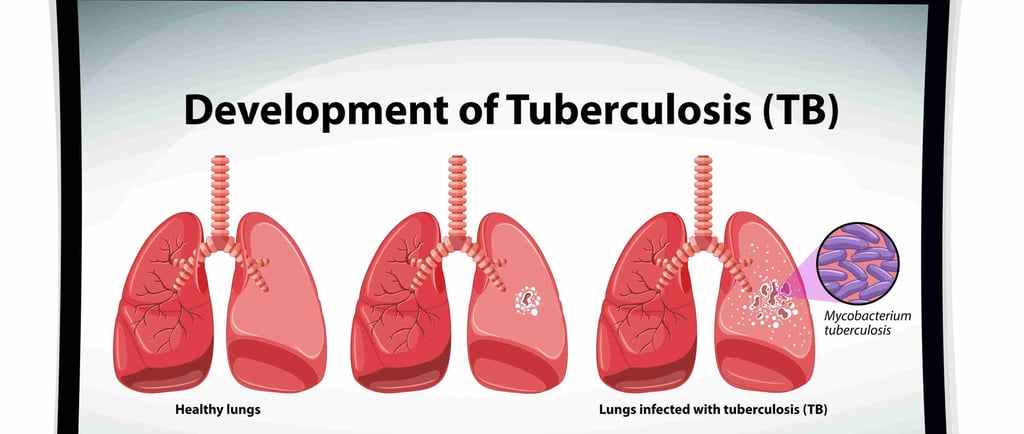Latent TB Risk Calculator
Assess your latent tuberculosis risk with our free Latent TB Risk Calculator. Get personalized insights, prevention tips, and actionable health recommendations instantly.
Check More Free Tools:


Free Latent TB Risk Calculator – Assess Your Tuberculosis Infection Probability
Latent tuberculosis infection (LTBI) occurs when Mycobacterium tuberculosis bacteria live dormant in your body without causing symptoms. Unlike active TB, latent TB isn't contagious but carries a 5-10% lifetime risk of activation. According to the WHO, 1.7 billion people (23% of global population) have latent TB, making risk assessment critical for prevention.
Key Terms Explained
TermDefinitionClinical SignificanceLTBIDormant TB infection without symptomsRequires monitoring/preventive treatmentActive TBContagious tuberculosis with symptomsRequires immediate multi-drug therapyIGRA TestInterferon-Gamma Release AssayPrimary LTBI diagnostic toolTSTTuberculin Skin Test (Mantoux test)Traditional LTBI screening methodBacillus Calmette-Guérin (BCG)TB vaccine used in endemic areasReduces severe TB complications
Symptoms: When Latent TB Becomes Active
LTBI has no symptoms, but activation causes:
Persistent cough (lasting >3 weeks, sometimes bloody)
Unexplained weight loss (>5% body weight in 1 month)
Night sweats (drenching episodes requiring bedding changes)
Fever (low-grade, typically evenings)
Chest pain (worsening with breathing/coughing)
High-risk groups: HIV+ individuals, diabetics, smokers, organ transplant recipients, and those on immunosuppressive therapies.
Diagnosis Procedures: Detecting the Invisible
1. Screening Tests
Tuberculin Skin Test (TST):
Measures skin reaction to tuberculin after 48-72 hours
False positives common in BCG-vaccinated individualsInterferon-Gamma Release Assays (IGRAs):
Blood tests detecting immune response to TB antigens (QuantiFERON/T-SPOT)
Preferred for BCG-vaccinated patients
2. Confirmatory Evaluation
Chest X-ray: Identifies Ghon foci (calcified granulomas)
Sputum Culture: Gold standard for active TB confirmation
GeneXpert MTB/RIF: PCR test detecting TB DNA and rifampicin resistance
CDC guidelines recommend LTBI testing for:
Close contacts of active TB patients
Healthcare workers
Immunocompromised individuals
Immigrants from high-TB-burden countries
Treatment Options: Preventing Activation
LTBI Treatment Protocols
RegimenDurationEfficacySide Effect RiskIsoniazid + Rifapentine3 months90% reductionLowRifampin4 months85% reductionModerateIsoniazid9 months80% reductionHigh (hepatotoxicity)
Contraindications:
Severe liver disease
Alcohol abuse
History of INH-induced hepatitis
Precautions: Breaking the Transmission Chain
Individual Prevention
Infection Control: N95 masks in healthcare settings
Nutrition: High-protein diet with vitamin D supplementation
Environmental: UV-C light in high-risk spaces (>30 µW/cm² intensity)
Public Health Strategies
Contact Tracing: Screen all close contacts of active TB cases
Targeted Testing: High-risk groups (prisons, shelters, HIV clinics)
Vaccination: BCG for children in endemic areas (70% efficacy against severe forms)
How Our Latent TB Risk Calculator Works
The calculator evaluates 15+ clinical factors through evidence-based scoring:
Key Calculation Parameters
Exposure Risk Points:
Confirmed TB contact: +35
Healthcare work: +20
Incarceration/homelessness: +25
Immune Status:
HIV: +50
Diabetes: +20
Biologic therapies (e.g., TNF-α inhibitors): +40
Demographic Factors:
Age <5 or >65: +15
BMI <18.5: +10
Result Interpretation
<30 Low Risk: Routine screening not indicated
31-70 Moderate Risk: Consider IGRA/TST testing
>70 High Risk: Urgent physician referral + preventive therapy
Example Calculation:
A 45-year-old nurse (healthcare exposure: +20) with diabetes (+20) and BMI 17 (+10) scores 50/100 → Moderate risk
Frequently Asked Questions (FAQs)
Q: Can latent TB spread to family members?
A: No. Only active pulmonary TB is contagious via airborne droplets.
Q: How often should high-risk individuals be tested?
A: Annual screening for healthcare workers/HIV+ patients; biennial for others with ongoing risk.
Q: Does BCG vaccination affect test results?
A: Yes. BCG causes false-positive TST but doesn't affect IGRA results.
Q: Can latent TB recur after treatment?
A: Reinfection is possible but treatment reduces activation risk by 90%.
Global LTBI Statistics
| Region | LTBI Prevalence | Activation Rate | |--------|-----------------|-----------------| | Africa | 40-60% | 10% lifetime | | Asia | 30-50% | 5-7% lifetime | | USA | 4-6% | 1% annual | | EU | 10-25% | 2-5% lifetime |
Source: WHO Global Tuberculosis Report 2023
Why Risk Assessment Matters
Early LTBI detection prevents:
90% of active TB cases with preventive therapy
$18,000 average US treatment costs per active TB case
Drug-resistant TB development from delayed treatment
"Treating LTBI is 25x more cost-effective than managing active TB"
– CDC Division of Tuberculosis Elimination
Take Action: Your Next Steps
Calculate Your Risk: Use our tool to assess personal LTBI probability
Consult Physicians if score >30 for testing options
Implement Prevention: BCG vaccination (where indicated), nutrition, and environmental controls
Share Awareness: Use social buttons to spread TB prevention knowledge
Disclaimer: This calculator provides screening guidance only. Always consult healthcare providers for medical decisions.
Explore our extensive range of health calculators.
For Appointments
Get Health insights & OFFERS
support@doseway.com
0318 - 6144650
© 2025. All rights reserved.
